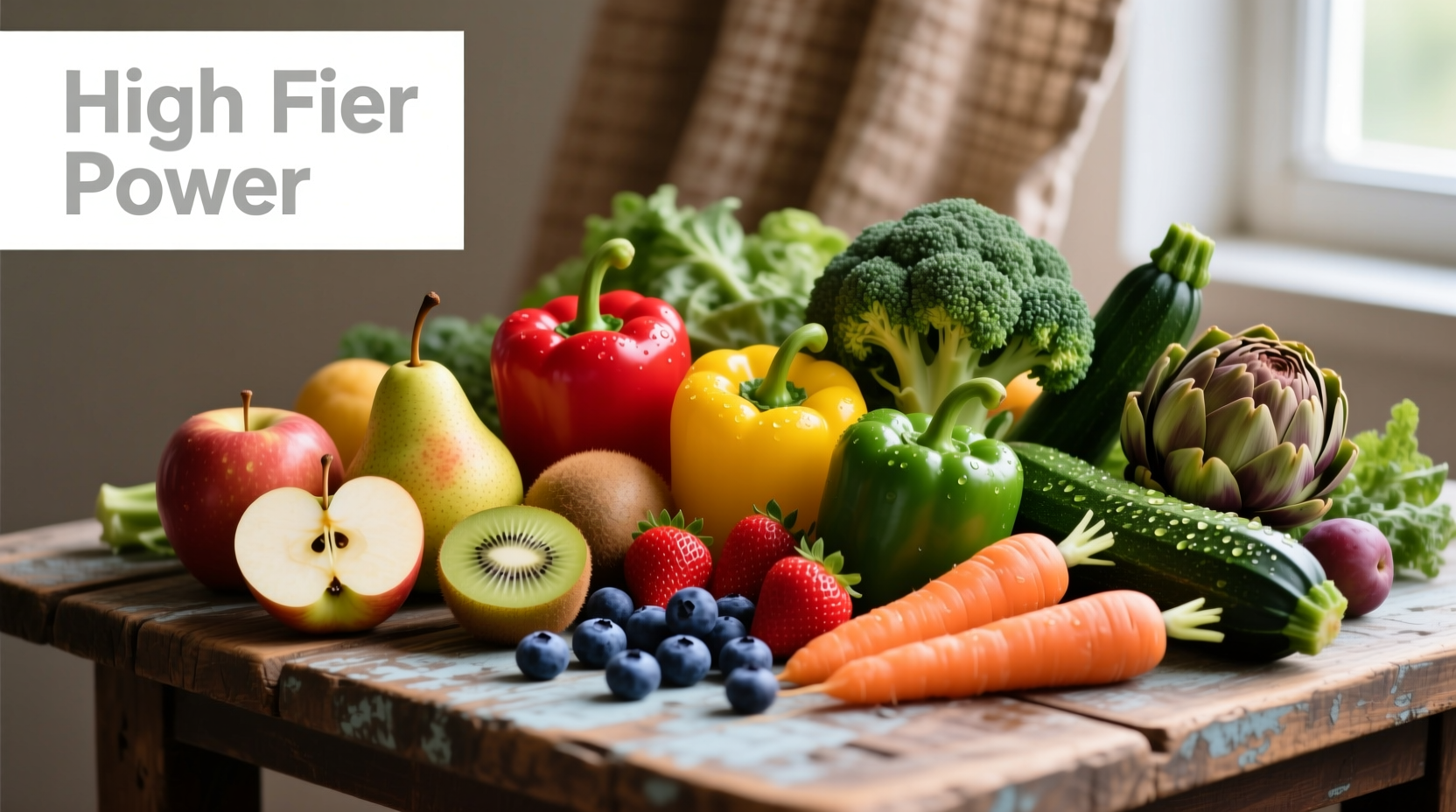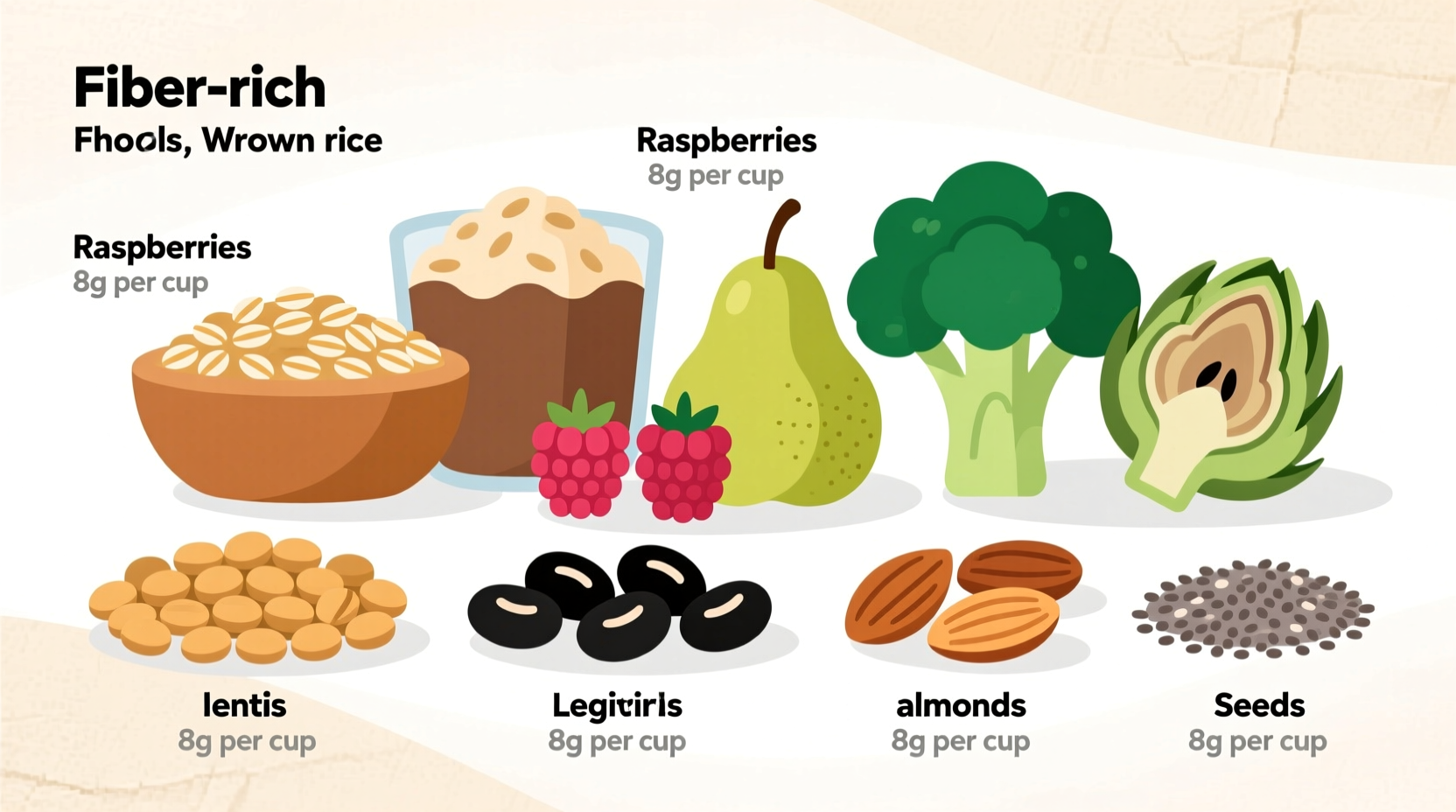When searching for what foods are fiber rich, you need accurate, science-backed information you can trust. Fiber plays a crucial role in digestive health, blood sugar regulation, and heart disease prevention, yet most adults consume only half the recommended daily amount. This guide cuts through the confusion with evidence-based recommendations from leading nutrition authorities.
Understanding Fiber: More Than Just Roughage
Fiber consists of indigestible carbohydrates found exclusively in plant-based foods. Unlike other nutrients, fiber passes through your digestive system largely intact, providing unique health benefits. The two primary types serve different functions:
- Soluble fiber dissolves in water to form a gel-like substance, slowing digestion and helping regulate blood sugar and cholesterol levels
- Insoluble fiber adds bulk to stool and speeds material through your digestive tract, preventing constipation
The National Academy of Medicine recommends 25 grams of fiber daily for women and 38 grams for men under 50, with slightly lower amounts for older adults. Unfortunately, only 5% of Americans meet these targets.
Top High-Fiber Food Categories
Legumes: The Fiber Powerhouses
Beans, lentils, and peas consistently rank among the highest fiber foods per serving. Just one cup of cooked black beans delivers approximately 15 grams of fiber—more than half your daily requirement.
| Food (1 cup cooked) | Total Fiber (g) | Soluble Fiber (g) |
|---|---|---|
| Split peas | 16.3 | 5.1 |
| Lentils | 15.6 | 4.8 |
| Black beans | 15.0 | 4.8 |
| Chickpeas | 12.5 | 3.9 |
According to research published in the American Heart Association's journal, regular legume consumption is associated with significantly lower risk of cardiovascular disease. The soluble fiber in beans binds to cholesterol particles, helping remove them from your body.
Whole Grains: Beyond Just Oats
While oats get much attention for their soluble fiber content, several whole grains offer impressive fiber profiles. Unlike refined grains, whole grains retain all three components of the grain kernel, including the fiber-rich bran layer.
Barley deserves special mention—particularly hulled barley (not pearl barley, which has had the bran removed). A single cup provides about 6 grams of fiber, with approximately 70% being soluble beta-glucan, the same compound that makes oats heart-healthy.
Fruits: Nature's Sweet Fiber Sources
Many fruits contain significant fiber, especially when eaten with their skins. Berries stand out for their exceptional fiber-to-sugar ratio:
- Raspberries: 8g fiber per cup
- Blackberries: 7.6g fiber per cup
- Pears: 5.5g fiber (with skin)
- Apples: 4.4g fiber (with skin)
The U.S. Food and Drug Administration specifically highlights berries as excellent sources of dietary fiber that provide substantial nutrition without excessive calories. Apples and pears contain pectin, a soluble fiber that feeds beneficial gut bacteria.

Vegetables: The Unsung Fiber Heroes
Dark leafy greens, cruciferous vegetables, and root vegetables all contribute meaningful fiber. Artichokes reign supreme—a medium artichoke contains approximately 6.9 grams of fiber.
Broccoli, Brussels sprouts, and avocados also deserve attention. One medium avocado provides about 10 grams of fiber, making it one of the highest-fiber fruits (yes, botanically a fruit!). The fiber in avocados comes with heart-healthy monounsaturated fats that enhance absorption of fat-soluble nutrients from other foods.
Nuts and Seeds: Concentrated Fiber Sources
Chia seeds and flaxseeds offer extraordinary fiber density. Just two tablespoons of chia seeds contain 10 grams of fiber, while the same amount of flaxseeds provides 4 grams.
According to a National Institutes of Health review, these seeds contain both soluble and insoluble fiber along with omega-3 fatty acids, creating a powerful combination for cardiovascular health. When incorporating these high-fiber seeds, remember to increase your water intake gradually to prevent digestive discomfort.
Practical Strategies for Increasing Fiber Intake
Knowing what foods are fiber rich is only half the battle. Implementing these evidence-based strategies will help you successfully incorporate more fiber into your daily routine:
Gradual Increase Method
Rather than dramatically increasing fiber overnight (which can cause bloating and gas), add 5 grams per day over several weeks. Start by replacing one refined grain product with a whole grain option, then add a serving of vegetables to one meal, and gradually build from there.
Hydration Is Essential
Fiber absorbs water in your digestive tract. Without adequate fluids, increased fiber intake can actually worsen constipation. Aim for at least 8 cups of water daily when boosting fiber consumption. Herbal teas and water-rich foods like cucumbers and watermelon also contribute to hydration.
Smart Swaps for Common Meals
Implement these simple substitutions that make a significant difference:
- Replace white rice with quinoa or brown rice (doubles fiber content)
- Choose whole-wheat pasta instead of regular pasta (adds 4-5g fiber per serving)
- Add beans to soups and salads (adds 7-8g fiber per ½ cup)
- Snack on an apple with almond butter instead of crackers (adds 3g fiber)
Evidence-Based Health Benefits of High-Fiber Diets
Research consistently demonstrates that adequate fiber intake provides numerous health advantages beyond basic digestion:
Digestive Health Improvements
A comprehensive analysis in the World Journal of Gastroenterology found that increased fiber consumption significantly reduces the risk of developing diverticular disease and hemorrhoids while improving symptoms of irritable bowel syndrome for many people.
Cardiovascular Protection
The soluble fiber in foods like oats, beans, and flaxseeds binds to cholesterol particles in your digestive system, preventing their absorption. A meta-analysis published in Circulation concluded that every 7-gram increase in daily fiber intake reduces the risk of heart disease by 9%.
Blood Sugar Management
Fiber slows the absorption of sugar, helping maintain stable blood glucose levels. The American Diabetes Association recommends high-fiber diets as part of diabetes management strategies, noting that soluble fiber particularly helps improve insulin sensitivity.
Avoiding Common Fiber Mistakes
Many people encounter challenges when trying to increase fiber intake. Understanding these common pitfalls will help you succeed:
- Mistake: Increasing fiber too quickly
Solution: Add 5 grams per day over several weeks while monitoring your body's response - Mistake: Not drinking enough water
Solution: Pair each high-fiber meal with a glass of water - Mistake: Relying solely on supplements
Solution: Focus on whole food sources first, using supplements only if necessary - Mistake: Choosing processed 'high-fiber' products with added sugar
Solution: Read labels carefully and prioritize minimally processed options
Special Considerations for Different Life Stages
Your fiber needs change throughout life. The Academy of Nutrition and Dietetics provides these age-specific recommendations:
- Children (1-3 years): 19g daily
- Children (4-8 years): 25g daily
- Boys (9-13 years): 31g daily
- Girls (9-13 years): 26g daily
- Adult men (50+): 30g daily
- Adult women (50+): 21g daily
For older adults, focus on soluble fiber sources like oats and beans, which are gentler on digestion. When introducing more fiber to children's diets, incorporate it through familiar foods like whole-grain pancakes or bean-based pasta sauces.
Frequently Asked Questions
What are the top 5 highest fiber foods per serving?
The top five highest fiber foods per standard serving are: 1) Chia seeds (10g per 2 tablespoons), 2) Split peas (16.3g per cup cooked), 3) Lentils (15.6g per cup cooked), 4) Black beans (15g per cup cooked), and 5) Artichokes (6.9g per medium artichoke). These foods provide substantial fiber density that can significantly contribute to your daily needs.
How can I tell if I'm getting enough fiber?
Signs you're getting adequate fiber include regular bowel movements (typically 1-3 per day), feeling full after meals without excessive hunger between meals, and stable energy levels. The most accurate method is tracking your intake using a nutrition app for several days. Most adults should aim for 25-38 grams daily depending on age and gender, with at least 10 grams coming from soluble fiber sources.
Can too much fiber be harmful?
Consuming excessive fiber (generally more than 70g daily) can cause digestive discomfort, interfere with mineral absorption, and potentially cause intestinal blockage in susceptible individuals. More commonly, people experience temporary bloating and gas when increasing fiber too quickly. The solution is gradual implementation paired with adequate hydration. If you have specific digestive conditions like Crohn's disease or ulcerative colitis, consult your healthcare provider about appropriate fiber intake.
What's the difference between soluble and insoluble fiber?
Soluble fiber dissolves in water to form a gel-like substance that slows digestion, helps regulate blood sugar, and lowers cholesterol. It's found in oats, beans, apples, and citrus fruits. Insoluble fiber doesn't dissolve in water; it adds bulk to stool and speeds material through your digestive tract, preventing constipation. It's predominant in whole wheat bran, vegetables, and nuts. Both types are essential for optimal digestive health, and most high-fiber foods contain a combination of both.
Do fiber supplements work as well as whole foods?
Fiber supplements can help meet daily requirements but don't provide the full spectrum of nutrients, phytochemicals, and health benefits found in whole food sources. Supplements like psyllium husk are effective for specific concerns like constipation or cholesterol management, but they should complement—not replace—fiber-rich whole foods in your diet. Whole foods offer additional vitamins, minerals, and antioxidants that work synergistically with fiber for optimal health benefits.











 浙公网安备
33010002000092号
浙公网安备
33010002000092号 浙B2-20120091-4
浙B2-20120091-4